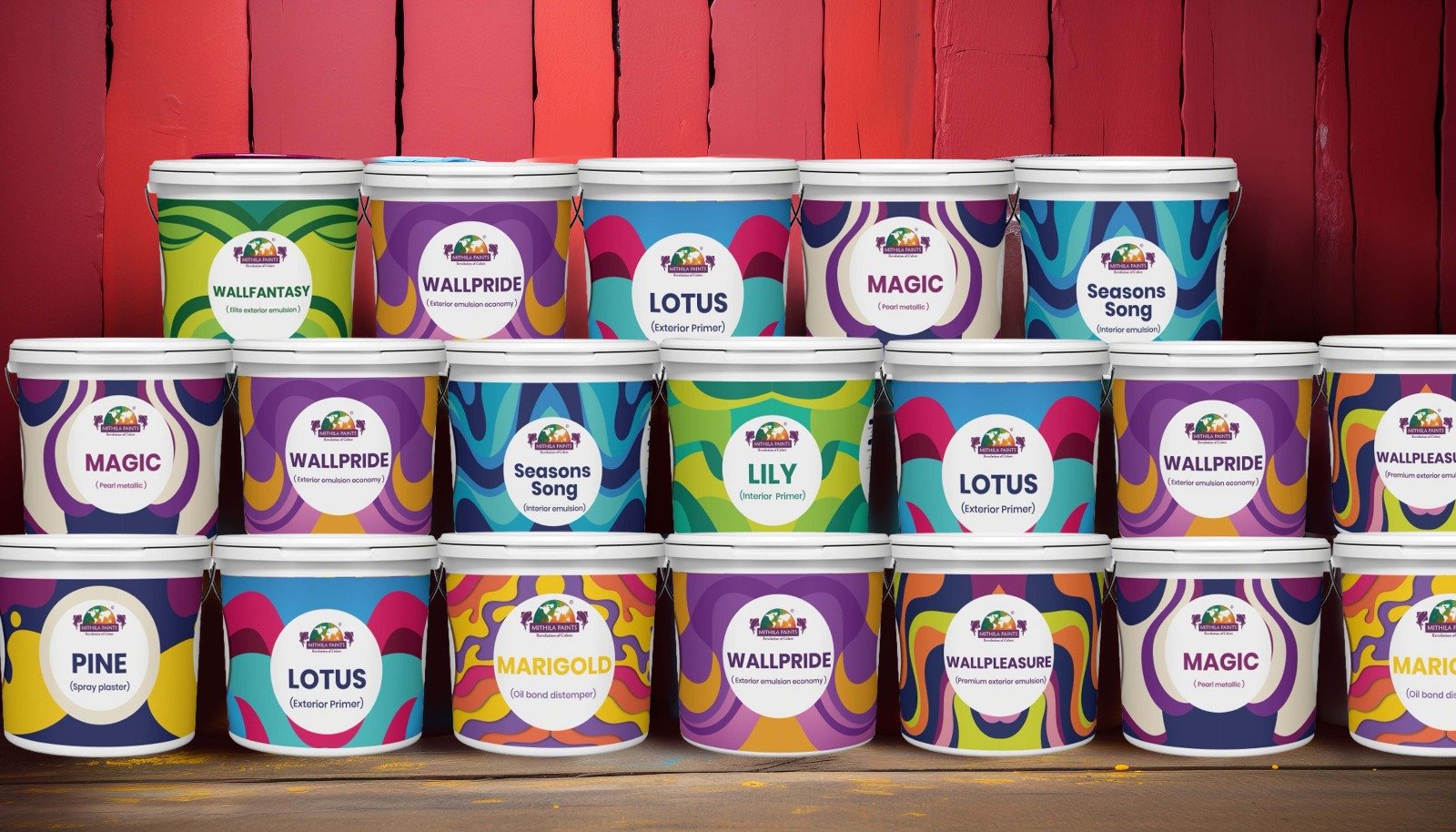Introduction to Mithila Paintings
Mithila paintings, or Mithila art, are a traditional form of painting that originated from the Mithila region in Bihar, India. This art form has a rich historical background that dates back several centuries, deeply rooted in the lives and cultural practices of local communities. Traditionally, these paintings were created by women on the walls and floors of their homes, primarily during special occasions and rituals, to depict their beliefs and celebrations.
The cultural significance of Mithila art lies in its vibrant portrayal of mythology, nature, and society. Each painting is a storyteller, often illustrating scenes from Hindu epics such as the Ramayana and Mahabharata, alongside natural elements and social themes that resonate with the community’s way of life. The use of vivid colors and intricate patterns not only brings life to the artwork but also serves as a medium to reflect the region’s cultural ethos. The motifs displayed often include flora, fauna, and symbols that hold religious importance, making Mithila paintings an essential aspect of the local spiritual landscape.
One of the unique features of Mithila paintings is the use of a variety of tools and techniques that make the artwork distinct. Traditionally, natural dyes and pigments were employed to create an impressive array of colors, and fine brushes made from twigs and the tips of bamboo were used to paint intricate patterns. The combination of its bold colors and detailed line work results in an art style that is both visually striking and culturally rich. As a form of expression, Mithila art plays a crucial role in the social and religious practices of the Mithila community, often accompanying festivities and rituals, thus maintaining a link between the past and present.

The History and Evolution of Mithila Art
Mithila art, also known as Mithila paintings, has its roots in the Mithila region of Bihar, India. This traditional form of art dates back to the early 20th century, where it was primarily practiced by women in the region. Initially, these paintings were created on the walls and floors of homes as a means of expressing cultural narratives, religious beliefs, and depicting seasonal changes. The vibrant colors, intricate patterns, and storyline-driven imagery in Mithila paintings reflect the life, customs, and traditions of the people living in this area.
The history of Mithila art can be traced back to several centuries, with some believing that the practice may have originated as far back as the ancient era, specifically linked to the depiction of the epic Ramayana and other significant religious texts. With the rise of regional governance and royal patronage, Mithila paintings began to gain recognition, transforming from folk art to a respected and valued cultural emblem. Notably, the influence of the ancient kings, who commissioned artists to decorate their palaces and temples, played a crucial role in the evolution of Mithila art.
Throughout the 20th century, Mithila paintings experienced significant transformations. The socio-political changes, including independence and modernization, introduced new themes and techniques into the art form. Artists began to experiment with a wider range of materials, moving from traditional surfaces like mud walls to canvas and paper. This change in medium expanded the reach of Mithila art beyond local boundaries, leading to exhibitions and global recognition.
Moreover, the involvement of organizations promoting these artists further led to the commercialization of Mithila paintings. While contemporary Mithila art still retains its traditional essence, it has also adapted to modern influences. The resulting hybrid is a dynamic representation of Mithila culture, showcasing its resilience and ability to evolve through time. The history and evolution of Mithila art reveal a rich tapestry of cultural heritage that continues to thrive in today’s art landscape.
Artistic Techniques and Materials Used
Mithila paints are not merely a visual representation; they embody a rich cultural heritage that is steeped in tradition. One of the defining characteristics of Mithila painting is the variety of materials and techniques employed by the artists. Traditionally, these artists utilize natural colors derived from plants, minerals, and even insects. For instance, the vivid red may come from madder roots, while yellows could be created from turmeric. The use of these eco-friendly pigments not only highlights the artist’s connection to nature but also ensures that the colors remain vibrant over time.
The brushes used in Mithila painting are unique and often hand-crafted. Artists typically employ tools made from twigs or the hair of animals, allowing for both fine lines and broader strokes. This versatility aids in the depiction of the intricate designs that Mithila art is renowned for. Lines in Mithila paintings are drawn with remarkable precision, showcasing a technique that has been perfected over generations. The artists often use a repetitive method of outlining patterns before filling them with color, creating a layered and textured effect.
An additional aspect of Mithila painting is the surfaces utilized. While traditional paintings may be done on walls, contemporary artists have adapted by using canvas, cotton, or handmade paper, expanding the medium’s accessibility. Each surface provides a different aesthetic and texture that can enhance the overall presentation of the art. Furthermore, the choice of surface is often influenced by the themes depicted. Naturalistic elements and intricate designs reflect the artists’ deep-rooted connection to their surroundings, symbolizing everything from nature to mythology.
In conclusion, the artistic techniques and materials used in Mithila paints are vital to preserving this unique cultural expression. The combination of natural pigments, handcrafted brushes, and diverse surfaces contributes to the intricate beauty and storytelling that characterize this remarkable art form.

Symbolism and Themes in Mithila Paintings
Mithila paintings, a traditional art form originating from the Mithila region in Bihar, India, are renowned for their vibrant colors and intricate designs, encapsulating the cultural and social narratives of the community. Central to these artworks is a rich tapestry of symbolism that conveys the deep-rooted beliefs and values of the Mithila people. Nature, mythology, and daily life emerge as predominant themes that reflect the ethos of this culture.
Nature plays a vital role in Mithila art, symbolizing harmony and interconnectedness. Common motifs, such as flora and fauna, are frequently depicted, representing fertility and life. The peacock, for example, symbolizes grace and beauty, while the lotus often represents purity and spiritual awakening. These elements highlight the profound respect the Mithila community holds for the natural world, viewing it as a source of inspiration and sustenance.
Mythology is another significant aspect of Mithila paintings, serving as a visual narrative of ancient stories and deities. Indeed, many pieces feature scenes from Hindu epics, such as the Ramayana and the Mahabharata. Characters like Lord Krishna and Goddess Durga are often illustrated, showcasing their virtues and stories through vibrant imagery. These mythological representations not only provide cultural continuity but also serve as a means of preserving oral traditions within the community.
Lastly, daily life is intricately woven into Mithila artistry. Scenes portraying agricultural practices, local festivals, and family life are commonly depicted, illustrating the rhythms of everyday existence. The motifs often reflect social customs and traditions, emphasizing the importance of community and familial bonds. The vibrant portrayal of these themes enriches Mithila paintings, making them not just decorative art, but also a storytelling medium that encapsulates the community’s lifestyle.
Famous Artists and Their Contributions
Mithila painting, a centuries-old art form from the Mithila region of Bihar, India, has been shaped and enriched through the contributions of various talented artists. Prominent among them is Bharti Dayal, who has played a significant role in popularizing Mithila paints outside of India. Known for her intricate designs that often depict nature and the divine, Dayal combines traditional techniques with contemporary themes. This fusion has attracted a global audience, making her a notable figure in the realm of Mithila art.
Another distinguished artist is Mukul Kumar, whose work is characterized by the vibrant use of colors and intricate patterns, often focusing on folklore and mythological narratives. Kumar’s meticulous attention to detail not only highlights the cultural significance of each piece but also showcases the mastery of the Mithila painting technique. He has exhibited his work internationally, gaining recognition that has further cemented the place of Mithila art on the world stage.
Sita Devi, often referred to as the “first lady of Mithila painting,” is a pioneering artist whose career has significantly influenced the art movement. Her paintings often reflect the lives of rural women and the vibrant cultural practices of the Mithila region. Through her exhibitions, she has been able to educate the global audience about the cultural context of Mithila paints, thus preserving its heritage while promoting its relevance today.
Each of these artists has not only contributed to the preservation and evolution of Mithila painting but has also inspired a new generation of artists. They have successfully navigated the challenges of modernity while staying true to their roots, ensuring that Mithila paints continue to thrive in contemporary art. Their efforts have resulted in Mithila art being celebrated and embraced both nationally and internationally, fostering a deeper appreciation for this unique cultural heritage.
Global Influence and Recognition of Mithila Art
Mithila paintings, originating from the Mithila region of Bihar, India, have transcended their local roots to capture the attention of a global audience. The intricate designs and vibrant colors that characterize these artworks reflect deep cultural narratives, making them appealing not only to traditional art enthusiasts but also to contemporary art collectors. As a result, Mithila paintings have gained recognition and appreciation beyond their geographical origins.
Cross-cultural exchanges have played a significant role in the dissemination of Mithila art. Many international art exhibitions and fairs have featured Mithila paintings, often alongside other forms of traditional art from India and around the world. Such platforms allow artists to showcase their work, while also educating global audiences about the rich cultural narratives and techniques inherent in Mithila art. This exposure has fostered a growing interest in and understanding of this unique art form, contributing to its popularity outside India.
The influence of global art markets cannot be understated in the promotion of Mithila paintings. As international collectors seek diversified art collections, the demand for Mithila paintings has surged. Art galleries and auction houses have begun to include Mithila artworks in their offerings, providing artists with opportunities for sales and exhibitions at prestigious venues. Through these platforms, artisans are not only able to gain economic support but also receive the validation and recognition that their work deserves.
Efforts are ongoing to preserve and promote Mithila art as an integral part of cultural heritage. Non-profit organizations and local communities are collaborating to sustain traditional practices and mentoring emerging artists. These initiatives aim to ensure that Mithila paintings continue to flourish and adapt while maintaining their authenticity, thereby solidifying their place in the global art narrative. Such endeavors highlight the importance of preserving this unique art form for future generations.
Challenges Faced by Mithila Artists
The contemporary landscape of Mithila paints, while rich in cultural significance, is fraught with challenges that threaten the very fabric of this traditional art form. One prominent issue is commercialization. As the demand for Mithila paintings has surged beyond local and national boundaries, many artists are compelled to cater to mainstream preferences, often compromising the authenticity of their work. This shift towards mass production can dilute the distinctive characteristics of Mithila art, leading to a homogenization that undermines its unique cultural value.
Moreover, the loss of traditional techniques poses another significant challenge. Many contemporary artists find themselves torn between the responsibility of preserving age-old methods and the necessity to adapt to modern techniques that may cater to a broader audience. Consequently, younger generations of artists may not receive adequate training in the authentic styles and narratives that define Mithila art. As these traditional techniques fade, the rich storytelling inherent in Mithila paints risks being diminished or entirely lost.
Globalization further complicates the situation. While it has undeniably opened new markets and provided exposure for Mithila artists, it has also subjected them to external influences that challenge their cultural identity. The influx of international art trends can lead some artists to abandon their roots, seeking to align their work with global tastes instead. This foundational disruption not only affects individual livelihoods but also threatens the communal associations linked to Mithila painting, as artists may gradually drift away from the cultural narratives that originally inspired their creations.
Thus, the future of Mithila paints and the artisans behind them hinges on striking a delicate balance between modernization and heritage preservation. Addressing these challenges is critical to ensuring that this vibrant art form continues to thrive while remaining true to its origins.
Reviving and Sustaining Mithila Art
Mithila art, a vibrant expression of Indian culture, faces both challenges and opportunities in its quest for sustainability. In recent years, various initiatives have emerged to revive this traditional art form, ensuring that it continues to thrive in contemporary society. One of the most effective avenues has been the organization of workshops that bring together established Mithila artists and eager learners. These workshops create an interactive environment where traditional techniques are passed down, encouraging a new generation to engage deeply with the art form.
Educational programs are also playing a vital role in promoting Mithila art. Institutions and community centers have begun offering courses that not only teach the technical aspects of painting but also highlight the rich cultural narratives behind the artwork. By integrating this cultural education into the curriculum, schools can foster an appreciation for Mithila paints among young students, thereby nurturing future artists who may contribute their own innovations to the tradition.
Community initiatives further strengthen the foundation of Mithila art. Grassroots organizations are working tirelessly to create platforms where local artists can exhibit their works, thereby increasing visibility and broadening their market reach. Such exposure not only uplifts the artists financially but also cultivates interest and respect for Mithila art within wider circles, both locally and internationally. Furthermore, the younger generation is encouraged to adapt Mithila themes into modern contexts, allowing them to express their voices while remaining connected to their heritage. As they infuse contemporary elements with traditional motifs, they help keep Mithila art relevant in today’s fast-paced world.
In conclusion, the collaborative efforts of workshops, educational programs, and community initiatives are pivotal in sustaining Mithila art. With active participation from the younger generation, this cherished cultural heritage can continue to flourish, blending the old and new while preserving its essence for future generations.
Conclusion: The Legacy of Mithila Paintings
Mithila paintings, a vibrant expression of Indian culture, have transcended generations, showcasing the rich heritage of the Mithila region in Bihar. Rooted deeply in tradition, these intricate artworks not only serve as decorative items but also narrate stories that reflect the social, religious, and cultural values of the community. In recent years, the significance of Mithila paints has seen a resurgence, igniting interest among art enthusiasts and cultural historians alike.
As we examine the continuing relevance of Mithila paintings in modern society, it becomes evident that their intricate designs and vibrant colors captivate a global audience. Artists of all ages are embracing this art form, thereby ensuring its preservation and evolution. The incorporation of Mithila motifs into contemporary designs, fashion, and home décor has reinforced its appeal, allowing it to flourish beyond traditional boundaries. Additionally, the advent of technology and social media has played a crucial role in providing artists with a platform to reach wider audiences, sharing the beauty of Mithila art with the world.
To secure the future of Mithila paintings, initiatives focused on education and training for aspiring artists must be prioritized. Workshops and online courses can instill a sense of pride and knowledge in younger generations, ensuring that traditional techniques are not lost. Moreover, collaborations between artisans and modern designers can foster innovative applications of Mithila paints, encouraging a synergy that celebrates both heritage and modernity. This blend of tradition and innovation will be vital for keeping the legacy of Mithila paintings vibrant and relevant.
In conclusion, the legacy of Mithila paintings continues to thrive, embodying the cultural richness of India. By fostering creativity and encouraging dialogue between past and present, Mithila art can remain an integral aspect of our artistic landscape, uniting communities and inspiring future generations.

